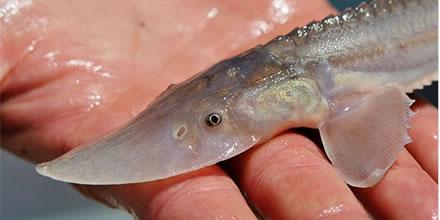Hayduke lives.
There is conscious action to remove the Glen Canyon Dam since Lake Mead could now hold the contents of Lake Powell.
Invasive species are plaguing dams in the Missouri River main stem dams.
Accumulated mercury in large fish causes spontaneous abortions yet testing record non-native salmon in Lake Oahe go untested.
Christopher Guy, assistant unit leader with the US Geological Survey Montana Cooperative Fishery Unit and professor at Montana State University, joined Dakota Midday host Karl Gerhke on Bill Janklow's idea of public radio to talk about the importance of recent findings on the endangered pallid sturgeon in the upper Missouri River basin.
Surprise!
There is conscious action to remove the Glen Canyon Dam since Lake Mead could now hold the contents of Lake Powell.
Over 3 million miles of rivers and streams have been etched into the geology of the United States, and many of those rivers flow into and over somewhere between 80,000 and two million dams. Yet only 3% of dams in the US are hydropower facilities—together supplying about just under 7% of U.S. power demand. Nearly one-third of dams in the national inventory list “recreation” as their raison d’être, a rather vague description.
Migratory fish can be visceral reminders of how a dam changes a river. Roughly 98% of the salmon population on the Elwha River disappeared after the dam went up, says Amy East, a research geologist at the U.S. Geological Survey (USGS). Dams not only upend ecosystems, they also erase portions of our culture and history. The decision to remove a dam is surprisingly simple. Consideration for Native American tribal rights may also influence decisions over whether to keep or kill a dam. Even Daniel Beard, Commissioner of Reclamation under the first Clinton Administration agrees there’s too many dams. He has been calling loudly and unequivocally for taking out one of the largest in the country, the Glen Canyon Dam. [The Undamming of America]29 tribes hold 20% of Colorado River rights.
With the oldest claims to water, the tribes command a considerable role in directing the region’s future. Combined, they hold rights to a substantial portion of the Colorado River’s flow: roughly 20 percent, or 2.9 million acre-feet, which is more water than Arizona’s allocation from the river. The tribal share, moreover, will increase, perhaps by as much as hundreds of thousands of acre-feet as the 13 tribes without confirmed rights settle their claims with federal and state governments. The power of settlements to shape the future is already apparent. New Mexico, for one, has set aside a portion of its unused share of the San Juan River, a Colorado River tributary, for tribal water rights settlements, according to the New Mexico Office of the State Engineer. [excerpt, Brett Walton, In Drying Colorado River Basin, Indian Tribes Are Water Dealmakers]The walk into the Colorado River in Lake Mead Recreation Area to Arizona Hot Springs is other-worldly. One can almost feel the eyes of the wildlife looking down at you while you hike. Most annoying, however, was the steady stream of airliners on approach to Las Vegas just thirty miles away as the vulture flies.
Invasive species are plaguing dams in the Missouri River main stem dams.
Accumulated mercury in large fish causes spontaneous abortions yet testing record non-native salmon in Lake Oahe go untested.
Christopher Guy, assistant unit leader with the US Geological Survey Montana Cooperative Fishery Unit and professor at Montana State University, joined Dakota Midday host Karl Gerhke on Bill Janklow's idea of public radio to talk about the importance of recent findings on the endangered pallid sturgeon in the upper Missouri River basin.
According to American Rivers, an advocacy group that tracks U.S. dam removals, 72 dams in 19 states were torn down in 2014, a record. That is roughly double the annual number from 10 years ago. Some 1,185 dams have been removed since 1912, according to the group. The fleet of U.S. dams, however, is still enormous. The Army Corps of Engineers counts at least 87,000 dams in its database. Removing dams produces its own benefits. Public safety is enhanced by reducing the risk of a dam failure, and moribund freshwater fisheries are rejuvenated when a segmented river is reconnected. [Circle of Blue]Below the Missouri River dams pallid sturgeon are showing signs of recovery but above?
Surprise!
Pallid sturgeon come from a genetic line that has lived on this planet for tens of millions of years; yet it has been decades since anyone has documented any of the enormous fish successfully producing young that survive to adulthood in the upper Missouri River basin. Now, fisheries scientists with the U.S. Geological Survey, Montana State University and the U.S. Fish and Wildlife Service have shown why, detailing for the first time the biological mechanism that has caused the long decline of pallid sturgeon in the Missouri River and led to its being placed on the endangered species list 25 years ago.
In a paper published this week in the journal Fisheries, the scientists show that oxygen-depleted dead zones between dams in the upper Missouri River are directly linked with the failure of endangered pallid sturgeon hatched embryos to survive to adulthood. Given what the new research shows about how no oxygen is available to hatched pallid sturgeon embryos, the authors of the paper propose that officials will need to consider innovative approaches to managing Missouri River reservoirs for pallid sturgeon conservation to have a chance. [press release, US Geological Survey]President Obama: decertify the dinosaurs that are the main stem dams, tear the earth fuckers down and rewild the West.

No comments:
Post a Comment